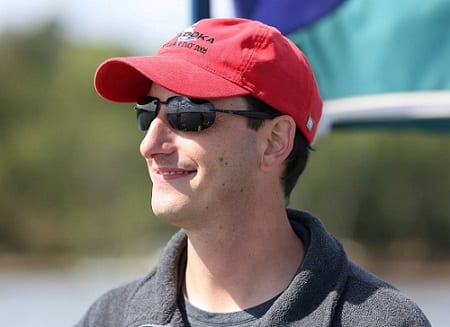
Patrick O’Donnell has an idea worth discussing! As the Club Race Officer at St. Croix Sailing Club in Hudson, Wisconsin, Patrick proposes an automated system of lights that would serve as an alternate to flags and eliminate the potential for human error in the visual signals.
He recently reached out to US Sailing to discuss this idea. What do you think?
A Q&A with Patrick O’Donnell
What kind of starting system do you envision?
I suggest an alternative solution to the start sequence flags used by Race Committees. I recommend using a set of lights controlled from our automated start timer (horn honker). The standard RRS 26 start sequence uses two time-sensitive flags: Warning and Preparatory. The rule tells us that “Times shall be taken from the visual signals…” rather than the sounds. My proposal could serve as an alternate to those flags with super-bright LED lights, which are at least as easy to see and can be automated.
How would your system improve the race starting system?
RC volunteers are often family members of sailors, club members putting in their volunteer time, or newcomers who are curious about sailboat racing. It’s not easy getting the timing of flags exactly right, and sometimes the flags are raised a second or more early or late. Yes, we can postpone and restart the sequence, but that throws off the entire class (and those to follow) and wastes time. This idea reduces the possibilities of errors and frees up a crew member to focus on other things, such as timing, recording or spotting the line.
Is anyone else using a lights system or something similar?
Riverton Yacht Club in New Jersey has used lights mounted to their clubhouse for many years now with great success. Their implementation is unbelievably creative, and while it may not be suitable to most clubs, they proved the concept quite nicely.
America’s Cup boats have used lights mounted near the helmsman to signal starts and penalties. That system would be expensive to implement and overly complex for most club’s needs, but again proves the concept. If any other clubs use lights to signal start sequences, I’d love to talk about what works for them.
Would this be economical to implement?
Cost is an important factor, since most race committees operate on shoestring budgets. LED technology has come a long way in the past 10 years. Fix an array of LEDs on a pole so they can be seen from every direction and wire them to the boat’s battery, and you already have an easier, more accurate, and possibly cheaper system than raising expensive flags. Obviously, the concept is a little more complex than that, but that’s the general idea. Integrating the lights into a start timer makes the whole operation even more efficient.
How did you get the idea for this system?
Our membership has declined somewhat over the years and finding crew for sailboats, let alone our Race Committee, has become more challenging each year. Seven years ago, I created my first automatic start timer to automate our horns. Since then, I’ve struggled with the engineering necessary to create automated flag tip-ups. Pistons, springs and motors all hold promise, but this device would need to work in blinding rain, freezing temperatures, 30 mph winds – and be almost 100% reliable.
This fall, while winterizing our committee boat, I noticed an LED stoplight down the road and the ideas started snowballing from there.
Starting races with flags is steeped in tradition – how do you think this change would be received?
This could be a revolutionary advancement in competitive sailing. Sailors these days are amazingly skilled and adept with their boats. They can cross the line within a fraction of a second of the start signal. Our race committees ought to be equally accurate. Don’t mistake me – I love flags and the tradition they bring to our sport. I simply suggest that they be removed from time-critical situations in favor of faster (ideally automated) mechanisms.
What issues still need to be resolved?
There are a few outstanding issues we need to resolve to make this a workable sequence for sailing clubs throughout the United States.
- How do we specify classes? For individual or non-rolling sequences, the class pennant could be raised throughout the sequence and independent of the timing – stated in the SI’s as such, there should be no issue. Rolling sequences complicates matters in several ways.
- Ditto for penalty flags (P, I, Z, U, Black) – the Prep signal would become a light bulb.
- Legal concerns – many light colors are reserved for anchoring, vessel configuration, law enforcement, and other uses. That limits the number of colors we could use. This system should work during daytime or nighttime in all navigable waters of the U.S. This may be a non-issue as the race committee is usually surrounded by sailboats when these signals are displayed, but we should come up with a proper protocol for our new lights.
About Patrick O’Donnell
Patrick grew up running the Race Committee boat with his dad in the 80’s for the St. Croix Sailing Club just outside of St. Paul, Minnesota. They were first certified as Club Race Officers in 1995. He took over full-time PRO duties 11 years ago and says he hasn’t missed a race since.
